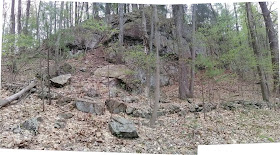Between Main Street and the massive scar of an earth products quarry, in a town park associated with some names very familiar to local historians, is hardly the remote location deep in some untended second growth woods usually associated with a Ceremonial Stone Landscape.
Over the past 30 years, I've come to realize that Orenaug Park contains many features that are elements of an Indigenous Ceremonial Stone Landscape:
"Ceremonial Stone Landscapes is the term used by USET, United Southern and Eastern Tribes, Inc.[1], a non-profit, intertribal organization of American Indians, for certain stone work sites in eastern North America. Elements often found at these sites include dry stone walls, rock piles (sometimes referred to as cairns), stone chambers, unusually-shaped boulders, split boulders with stones inserted in the split, and boulders propped up off the ground with smaller rocks. While neither the age of these sites nor the idea of their creation by indigenous peoples has been accepted generally, interest in the sites is increasing. This interest is generated in part by USET's Resolution #2007:037 [2], entitled Sacred Ceremonial Stone Landscapes Found in the Ancestral Territories of United Southern and Eastern Tribes, Inc. Member Tribes.
Over the past 30 years, I've come to realize that Orenaug Park contains many features that are elements of an Indigenous Ceremonial Stone Landscape:
"Ceremonial Stone Landscapes is the term used by USET, United Southern and Eastern Tribes, Inc.[1], a non-profit, intertribal organization of American Indians, for certain stone work sites in eastern North America. Elements often found at these sites include dry stone walls, rock piles (sometimes referred to as cairns), stone chambers, unusually-shaped boulders, split boulders with stones inserted in the split, and boulders propped up off the ground with smaller rocks. While neither the age of these sites nor the idea of their creation by indigenous peoples has been accepted generally, interest in the sites is increasing. This interest is generated in part by USET's Resolution #2007:037 [2], entitled Sacred Ceremonial Stone Landscapes Found in the Ancestral Territories of United Southern and Eastern Tribes, Inc. Member Tribes.
Sections of the USET resolution describing these sites read as follows:
The resolution goes on to request that the federal government work to understand and preserve the stone landscapes."
My friend Diane Dix writes:
"In 2008, members of the Nolumbeka Project were instrumental in proving the eligibility of the Turners Falls (MA) Sacred Hill Ceremonial Site for the National Register of Historic Places. Without this intervention, the site would have been destroyed by the extension of the airport’s runway. Nolumbeka Project members assisted by providing records from our Archives; giving first person accounts verifying the sacred nature of the area; clearing brush; monitoring the site; and participating in important meetings. [Visit http://www.nps.gov/nr/publications/guidance/TurnerFallsDOEDecision-Redacted.pdf for details about this important preservation success]
...the lithic remains of the Native Americans of New England remained hidden in plain view for centuries. Many of these features are constructed with stone and blend quietly and reverently into the natural surroundings. Yet, once one awakens to their presence they seem to be everywhere. Most were constructed hundreds, even thousands of years ago, when the Indians burned much of the land to control the vegetation and foliage did not obstruct the sightlines. Often these monuments lead the eyes to the place where the earth meets the sky..."
Ceremonial Stone Landscapes are also being recognized and preserved by some towns, through "Memoranda of Understanding" with Indigenous Peoples, such as Wendell MA:
"A group of collaborating Native American tribes has offered to work with Massachusetts towns to identify landscapes of ceremonial or religious significance to their heritage, and Wendell is taking them up on that.
The history of indigenous ceremonial stone landscapes and the importance of maintaining their integrity and tranquility was explained to the Selectboard by Doug Harris, deputy tribal historic preservation officer for the Narragansett Indian Tribal Historic Preservation Office in Charlestown, R.I.
The Wampanoag Tribe of Gay Head (Aquinnah) and the Pequot, Mohegan and Narragansett tribes are collaborating on this and have signed a memorandum of understanding with Wendell to share authority of sites of an indigenous nature..."
Below: Snake Qusukqaniyutôk (‘stone row, enclosure) around outcrop at Orenaug.
An overlay illustration:
To be continued...




No comments:
Post a Comment